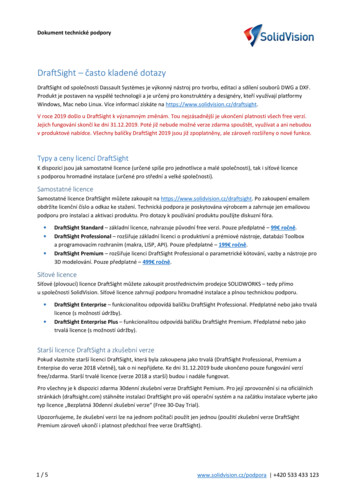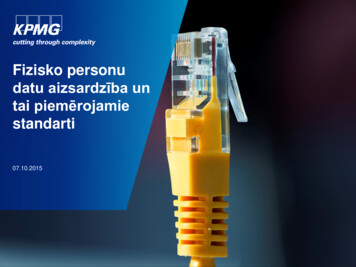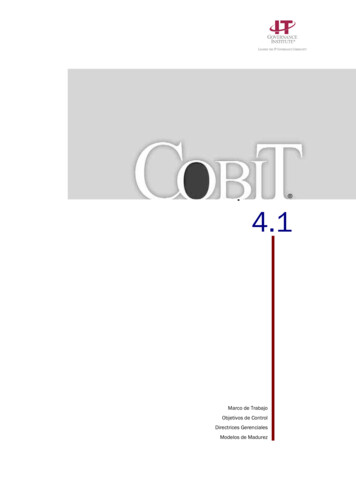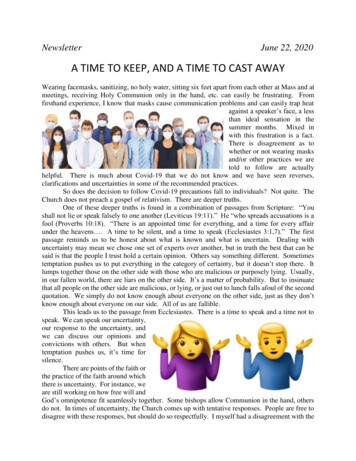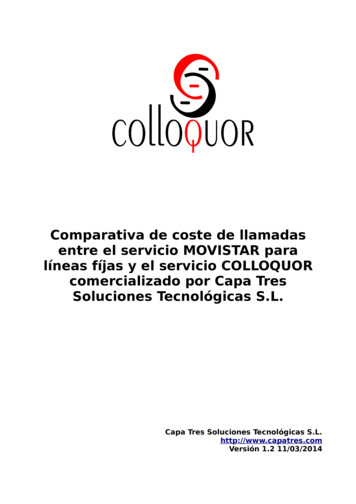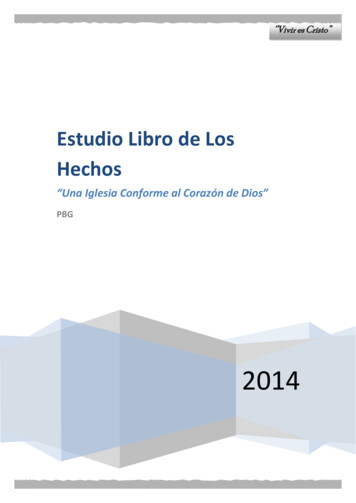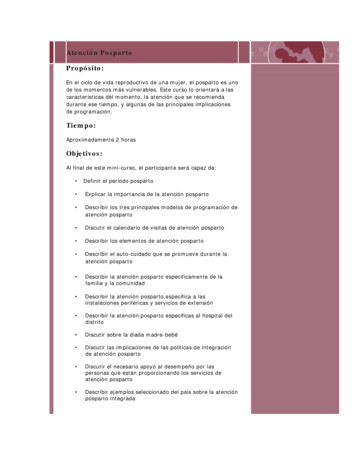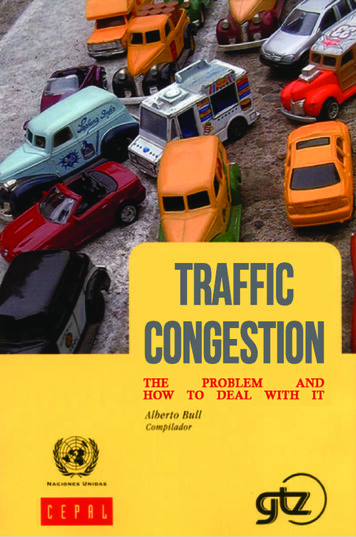
Transcription
cionalesLibros instituLibros de la CEPALOBSERVATORIO DEMOGRÁFICOEPALRevista CPublicacionesde la CEPALPáginas SelectasInformes AnualesGracias por su interés en estapublicación de la CEPALCuadernos EstadísticosNotas de PoblaciónManuales de la CEPALLibros de la CEPALSi desea recibir información oportuna sobre nuestros productoseditoriales y actividades, le invitamos a registrarse. Podrá definir susáreas de interés y acceder a nuestros productos en otros formatos.Deseo com/publicacionesdelacepal
CUADERNOS DE LA CEPAL87TRAFFIC CONGESTIONTHE PROBLEM AND HOWTO DEAL WITH ITAlberto BullEditorEconomic Commissionfor Latin Americaand the CaribbeanDeutsche Gesellschaft fürTechnische Zusammenarbelt(GTZ) GmbHSantiago, Chile, 20033
LC/G.2199-PJanuary 2004This book was prepared within the framework of the Project on the Use of Road Tollsin Latin American Cities, which was carried out by the Transport Unit of the NaturalResources and Infrastructure Division of the Economic Commission for Latin Americaand the Caribbean (ECLAC) with funding from the German Agency for TechnicalCooperation (GTZ) of the Federal Republic of Germany. The Chilean Ministry ofPlanning and Cooperation has kindly given its authorization for the use of theESTRAUS, VERDI and MODEM transit models.Alberto Bull of the ECLAC Transport Unit was in charge of editorial coordinationfor this project. The following individuals also contributed directly to the preparationof the book: Ian Thomson, Chief of the ECLAC Transport Unit; Vicente Pardo,Consultant with the ECLAC Transport Unit; Alan Thomas of the Inter-AgencySecretariat for Transport Planning of Chile (SPECTRA); Gisèle Labarthe and DianaMery; Juan Pablo Diez, former Consultant with the ECLAC Transport Unit; Dr. LuisCifuentes, Professor in the Industrial and Systems Engineering Department of theCatholic University of Chile.Daniela Simioni, of the ECLAC Sustainable Development and HumanSettlements Division, read the draft and made constructive observations and comments.Copyright United Nations 2004All rights reservedPrinted in ChileApplications for the right to reproduce this work or parts thereof are welcomed andshould be sent to the Secretary of the Publications Board, United Nations Headquarters,New York, N.Y. 10017, U.S.A. Member States and their governmental institutions mayreproduce this work without application, but are requested to mention the source andinform the United Nations of such reproduction.UNITED NATIONS PUBLICATIONSales No. E.03.II.G.88ISSN printed version: 0252-2195ISSN online version: 1727-0413ISBN: 92-1-121432-74
INDEXPageSUMMARY .13CHAPTER IA LIVABLE, COMPETITIVE AND SUSTAINABLE CITY .1. Congestion: an escalating negative phenomenon .2. Damage to competitiveness .3. Cities for living, developing and moving about .19192021CHAPTER IITHE CAUSES AND COSTS OF CONGESTION .A. WHAT IS CONGESTION? .1. Popular usage and dictionary definition .2. A technical explanation .3. Towards a practical definition in the case of road traffic .B. THE CAUSES OF CONGESTION .1. Characteristics of urban transport which cause congestion .2. The problem is mainly caused by private car users .3. The state of the roads and driving habits also contribute tocongestion .4. There is also an institutional problem .C. THE INVASION OF THE PRIVATE CAR.1. Economic reforms have made private cars more easilyaccessible .2. The popularization of private car ownership .3. Where there are fewer cars it nevertheless seems harderto get about .4. The strong influence of subjective factors .D. HOW SERIOUS IS THE PROBLEM, AND WHO SUFFERS ITSEFFECTS? .1. Various indicators point to a serious and worseningsituation .2. Who pays the costs of congestion? .2323232325262627283030313134353737395
PageE. HOW TO TACKLE THE SITUATION .1. A little congestion does no harm .2. The authorities should take a new view of the situation .3. An integral approach is called for .CHAPTER IIICONTROLLING CONGESTION THROUGH SUPPLY-SIDEACTIONS .A. TRANSPORT SUPPLY AND THE CITY .1. What is transport supply? .2. Frequent calls to expand transport supply .3. Cities are for living and moving .B. ACTIONS ON INTERSECTIONS .1. Types of intersections .2. Intersection design .3. Intersection control systems .C. ACTIONS ON ROADWAYS .1. Expansion of physical capacity .2. Reversible-flow roads .D. SYNCHRONIZATION OF TRAFFIC LIGHTS .1. Synchronization with fixed plans .2. Flexible or dynamic synchronization .3. Centralized control systems .E. EXCLUSIVE LANES AND STREETS FOR MASS TRANSIT .1. Bus-only lanes .2. Segregated bus lanes .3. Bus-only streets .4. Public transit reorganized with the equivalent of a surfacesubway .F. HIGH QUALITY PUBLIC TRANSIT SYSTEMS .1. Executive buses .2. Attracting drivers .3. Are executive buses viable? .4. Collective taxis .H. RAILROAD OR SUBWAY SYSTEMS .1. A historical introduction .2. Where do subway passengers come from? .3. An explanation for subways’ inability to reducecongestion .4. Consequences of denser land use .5. How can subways help reduce congestion? 717373737474757576777778
PageI. ADVANTAGES AND DISADVANTAGES OF SUPPLY-SIDEMEASURES .1. Advantages .2. Disadvantages .J. ONGOING, CONSISTENT ADJUSTMENT OF SUPPLY .CHAPTER IVCONTROLLING CONGESTION WITH DEMAND-SIDE ACTIONSA. TRANSPORT DEMAND AND URBAN CONGESTION .1. What is transport demand?.2. Both supply-side and demand-side action is required .3. Demand-side measures that prevent congestion .B. CONTROLLING PARKING .1. Description of the measure .2. Free or unrestricted on-street parking .3. Regulated or paid on-street parking .4. Paid off-street parking .5. Free off-street parking .6. Intermediary parking .7. Advantages and disadvantages of controlling parking .C. FLEX TIME .1. Description of the measure .2. Specifit cases .3. Advantages and disadvantages .D. RESTRICTING VEHICLES .1. Description of the measure .2. Effectiveness of the restriction .3. Examples of application .4. Advantages and disadvantages .E. ROAD PRICING .1. Description of the measure .2. Expected results of pricing .3. Matters to resolve .4. Examples of application .5. Advantages and disadvantages .F. EASING CONGESTION ON THE BASIS OF PERSONALCONVICTION AND REDUCING THE NEED TO TRAVEL .1. Personalized travel planning .2. Driver education .3. Modern communication technologies .G. CONGESTION AND LAND USE .1. Long-term trends .2. Availability of time to travel .3. Road pricing and land use .H. LIGHTS AND SHADOWS OF DEMAND-SIDE ACTIONS 231257
PageCHAPTER VSIMULATION AND EVALUATION OF ANTI-CONGESTIONMEASURES IN THE CASE OF SANTIAGO, CHILE .A. TRANSPORT AND TRANSIT IN SANTIAGO .1. A difficult situation that threatens to become unmanageable .2. The city has not remained idle .B. THE ESTRAUS AND VERDI MODELS .1. The ESTRAUS Model .2. The VERDI Model .C. SUMMARY OF SIMULATIONS AND EVALUATIONS .1. Segregated bus lanes .2. Executive buses .3. Prohibiting parking .4. Road pricing .5. Combining segregated bus lanes with parking prohibitions .6. Combining segregated bus lanes with road pricing .D. RECOMMENDATIONS FOR SANTIAGO .1. Progress achieved by previous measures .2. Recapitulation of the measures’ results .3. Can the recommendations be extrapolated? 49150CHAPTER VICONGESTION AND ENVIRONMENTAL POLLUTION . 151A. ATMOSPHERIC CONTAMINANTS . 1511. Admospheric contaminants wity local and regional effects . 1512. Impacts of atmospheric contaminants with local and regionaleffects . 1523. Global contaminants and their effect . 153B. INCIDENCE OF VEHICLE TRAFFIC ON POLLUTION . 1541. Types of contaminants emitted by vehicles . 1542. Relative importance of vehicle-generated contaminants . 1553. One way to estimate the amount of contaminants emittedby vehicles . 156C. EFFECTS OF REDUCED CONGESTION ON POLLUTION . 1571. Change in emission factors caused by change in speedof travel . 1572. Change in distance travelled for each mode . 1593. Change in fuel consumption . 160D. RESULTS OF SOME ANTI-CONGESTION MEASURES STUDIEDIN SANTIAGO . 1601. Description of the measures analysed . 1602. The MODEM Model for calculating emissions . 1618
Page3. Changes in emissions upon implementation ofanti-congestion measures .4. Quantification of health effects resulting from emissionschanges .E. CONCLUSIONS .163165171CHAPTER VIICONCLUSION .1. Many travellers prefer congestion to leaving their carsat home .2. Begin with supply-side measures .3. Demand-side measures also have a place .4. Why take action against congestion? .5. What next? .173174176177178BIBLIOGRAPHY .181Tables, figures, illustrations, maps and boxesTable II.1Ecuador and Peru: imports of passenger vehicles .Table II.2Brazil: apparent consumption of automobiles .Table II.3Santiago, Chile (three municipalities): estimatedrelation between increase in automobile ownershipper family and increase in average income .Table II.4São Paulo: relative incomes of users of differentmeans of transport, 1977 .Table II.5Brazilian cities: increase in operating costs of publictransport due to traffic congestion .Table III.1Criteria for installing a stop sign .Table III.2Justification of a signal by vehicle volume .Table III.3Justification of a signal by delays in secondaryaccess .Table III.4Santiago: time saved on reversible-flow roads .Table III.5Time savings on a segregated lane in Santiago(morning rush hour) .Table III.6Time savings with bus-only streets in Santiago(morning rush hour) .Table III.7Trips on modes other than the subway within thesubway’s sphere of influence in Greater Santiago,1991 .Table V.1Santiago: essential characteristics of transit duringmorning rush hour (7:30 a.m. to 8:30 a.m.) .Table V.2Santiago: executive buses, results of ESTRAUS(for rush hour) and VERDI models .1733233344041585960626970781281379
PageTable V.3Table V.4Table V.5Table V.6Table V.7Table V.8Table VI.1Table VI.2Table VI.3Table VI.4Table VI.5Table VI.6Table VI.7Table VI.8Table VI.9Figure II.1Figure III.1Figure III.2Figure III.3Figure III.4Figure III.5Figure III.610Santiago: prohibiting parking, results of ESTRAUS(for rush hour) and VERDI models .Santiago: road pricing scenarios .Santiago: road pricing measures, results of ESTRAUS(for rush hour) and VERDI models .Santiago: road pricing measures, results of ESTRAUS,(for rush hour) and VERDI models .Santiago: segregated bus lanes combined withparking prohibitions on the street (with and withoutparking metres). Results of the STRAUS(for rush hour) and VERDI models .Santiago: segregated bus lanes combined with a tollof 1,000 pesos for crossing the Américo Vespuciobeltway. Results of the ESTRAUS (for rush hour)and VERDI models .Health problems with greater incidence caused byatmospheric contaminants .Principal contaminants emitted by motor vehicles .Categories of vehicle considered by the modemmodel .Santiago: emission changes in tons per year withthe introduction of segregated bus lanes and a tollof 2,000 pesos for crossing the Américo Vespuciobeltway .Santiago: emission changes in tons per year due tointroduction of executive buses .Santiago: percentages of total emission changes foreach measure analysed .Unitary values in 1997 dollars used for each healtheffect produced by environmental pollution .Value of health efffects resulting from one-tonchange in emission of a contaminant .Santiago: social benefits for transport and pollutioncorresponding to anti-congestion measures analysed .Schematic representation of the concept of trafficcongestion .“T” intersections .“Y” intersections .Crossroads .Roundabouts and mini-roundabouts .Procedure for choosing a stop or yield sign .Three examples of bus-only lanes 5152535767
PageFigure V.1Figure VI.1ESTRAUS, VERDI and MODEM models .Incidence of mobile sources on contaminant emissionsin the Santiago Metropolitan Region .Figure VI.2Unitary nitrogenous oxide (NOx) emissions of euro Iand conventional vehicles.Figure VI.3Unitary variation in emissions as a function of vehiclespeed and technology .Figure VI.4Santiago: environmental social benefits of roadpricing measures, as a percentage of directtransport benefits .Illustration II.1 The selfish and undisciplined behaviour of Limamotorists reduces the capacity of the road system toa fraction of its real potential .Map V.1Segregated bus lanes .Map V.2Executive bus routes .Map V.3Areas where parking is prohibited .Map V.4Road pricing in downtown plus Avenida ProvidenciaMap V.5Américo Vespucio beltway .Box III.1Bogota’s transmilenio system .Box IV.1Parking measures help reduce unemployment andcongestion in Santiago .Box IV.2Long-term parking restrictions .Box IV.3Parking regulation study in London .Box IV.4Paying commuters to leave their cars at home .Box IV.5Intermediary parking in the United States .Box IV.6Various initiatives restricting cars and favouringalternatives in Bogota .Box IV.7A citizen project in São Paulo .Box IV.8Vehicle restriction for environmental reasonsin Santiago .Box IV.9Possible future collection system .Box IV.10Charging urban tolls in Norway .Box IV.11Road pricing in London .Box IV.12Travel BlendingTM, a tool for changing transportbehaviour .Box V.1Application of ESTRAUS in Santiago, Chile 610711211411511913011
12
SUMMARYCongestion: a serious and worsening problemTraffic congestion has been increasing in much of the world, developedor not, and everything indicates that it will continue to get worse, representingan undoubted menace to the quality of urban life. Its main expression is aprogressive reduction in traffic speeds, resulting in increases in journey times,fuel consumption, other operating costs and environmental pollution, ascompared with an uninterrupted traffic flow.Congestion is mainly due to the intensive use of automobiles, whoseownership has spread massively in Latin America in recent decades. Privatecars have advantages in terms of facilitating personal mobility, and they givea sensation of security and even of heightened status, especially in developingcountries. They are not an efficient means of passenger transport, however,since on average at rush hours each occupant of a private car causes about 11times as much congestion as a passenger on a bus.The situation is further aggravated in the region by problems of roaddesign and maintenance in the cities, a style of driving which shows littlerespect for other road users, faulty information on traffic conditions, andunsuitable management by the responsible authorities, which are often splitup among a host of different bodies.The cost of congestion is extremely high. According to conservativecalculations, for example, increasing the average speed of private car journeysby 1 km/hr and that of public transport by 0.5 km/hr would give a reductionin journey times and operating costs worth the equivalent of 0.1% of the grossdomestic product (GDP) (Thomson, 2000b).The harmful effects of congestion are suffered directly by the vehiclesthat are trying to circulate. They are not only suffered by motorists, however,but also by users of public transport –generally lower-income persons–whonot only take longer to travel from one place to another but also have to payhigher fares on account of congestion. All city-dwellers are also adverselyaffected, in terms of a deterioration in their quality of life through such factorsas greater air and noise pollution and the negative long-term impact on thehealthiness and sustainability of their cities, all of which makes it vitallynecessary to keep congestion under control.13
Make a start with measures affecting supplyThe most logical approach is to tackle congestion through measuresaffecting the supply of transport, i.e., the availability and quality of the transportinfrastructure, vehicles and their management, since this represents an increasein the capacity for travel.There are many shortcomings in the current urban road systems whichneed to be put right: it is necessary to improve the design of intersections,mark roads properly and provide them with suitable signs, and correct theoperating cycles of traffic lights, for example. Another possible measure wouldbe to make the traffic flow in the main avenues reversible at rush hours. Thesemeasures can relieve congestion considerably and do not usually cost much,the main requirement being a knowledge of traffic engineering.The construction of new roads or the widening of existing ones shouldnot be ruled out, when appropriate and feasible within the context of aharmonious form of urban development which provides for adequate spacesfor pedestrians and preserves the architectural heritage. It should be borne inmind, however, that building more and more roads, under- and overpassesand urban expressways may be counter-productive in the medium and longterm and may actually make congestion even worse, as we have unfortunatelyseen in the cases of some cities which adopted this strategy.Big savings may be obtained through a system of traffic lights run froma central computer. The rather high cost of this system in the view of manymunicipalities might make it advisable to set about this programme initiallyin several stages and only in certain sectors of the city, beginning with theprogressive replacement of obsolete traffic lights by newer ones suited to thenecessary technology. The application of this system in areas of heavy trafficwould show off its virtues and obtain citizen support for its wider use.Another very real need is to organize a public transport system whichprovides effective service. Substantial benefits are provided, not only for busesbut also for private cars, by segregated lanes for public transport. It may alsobe necessary to reorganize the bus lines into trunk and feeder lines, to givethem certain preferential traffic rights, and to improve the quality of the busesused and the business capacity of their operators. Buses of a higher standardthan those generally in service may also have a useful role to play, especiallyif their operating timetables and frequencies allow them to offer a viablealternative to private car users.A significant contribution can be made by transport systems similar toabove-ground subway lines, organized on the basis of buses running in theirown segregated lanes, with regular journey frequencies, centralized control,boarding and alighting of passengers only at designated stations, and arequirement that passengers must purchase their tickets before boarding thebus. Although installing these systems is a complex matter and the constructionof the necessary infrastructure will assuredly need the contribution of public14
resources, the excellent results obtained in Curitiba, the Quito trolleybus systemand the Transmilenio public transport system in Bogotá fully justify thissolution, which costs only a fraction of the construction of an undergroundsubway system.It is important that public transport should be improved in order to providea rapid service of decent standard and thus maintain the present proportion ofjourneys made by this means. In developing countries, over half of all journeys–and as much as 80% in some cities—are made by public transport.If well designed and executed, measures affecting supply offer aninteresting potential for tackling congestion. Even so, it is necessary toincorporate other measures, especially respecting demand, to be able to solvethe imbalances in infrastructure use and aid in achieving an acceptable balancefor the community as a whole.Measures aimed at demand also have a role to playThe aim of these measures is to persuade a substantial number of privatecar users travelling at rush hours or in areas of heavy traffic to use higherdensity forms of transport, use non-motorized means of transport, or changethe times at which they travel.Some measures may involve the application of regulations andrestrictions. Others may provide economic rewards or disincentives foradopting forms of conduct t
Publicaciones de la CEPAL Gracias por su interés en esta publicación de la CEPAL Si desea recib
